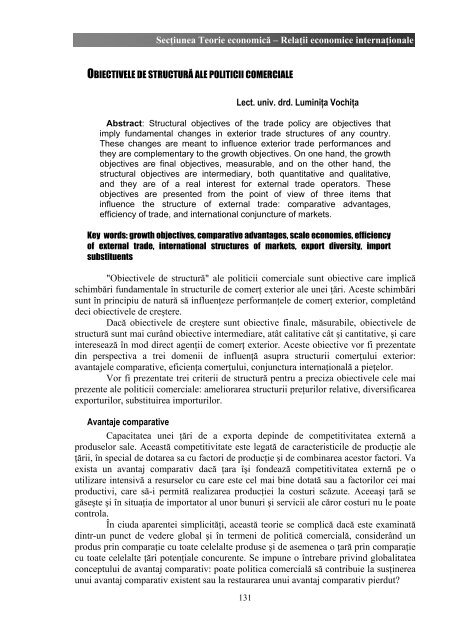PARTEA I - Centru E-learning de Instruire al Resurselor Umane din ...
PARTEA I - Centru E-learning de Instruire al Resurselor Umane din ...
PARTEA I - Centru E-learning de Instruire al Resurselor Umane din ...
You also want an ePaper? Increase the reach of your titles
YUMPU automatically turns print PDFs into web optimized ePapers that Google loves.
Secţiunea Teorie economică – Relaţii economice internaţion<strong>al</strong>e<br />
OBIECTIVELE DE STRUCTURĂ ALE POLITICII COMERCIALE<br />
Lect. univ. drd. Luminiţa Vochiţa<br />
Abstract: Structur<strong>al</strong> objectives of the tra<strong>de</strong> policy are objectives that<br />
imply fundament<strong>al</strong> changes in exterior tra<strong>de</strong> structures of any country.<br />
These changes are meant to influence exterior tra<strong>de</strong> performances and<br />
they are complementary to the growth objectives. On one hand, the growth<br />
objectives are fin<strong>al</strong> objectives, measurable, and on the other hand, the<br />
structur<strong>al</strong> objectives are intermediary, both quantitative and qu<strong>al</strong>itative,<br />
and they are of a re<strong>al</strong> interest for extern<strong>al</strong> tra<strong>de</strong> operators. These<br />
objectives are presented from the point of view of three items that<br />
influence the structure of extern<strong>al</strong> tra<strong>de</strong>: comparative advantages,<br />
efficiency of tra<strong>de</strong>, and internation<strong>al</strong> conjuncture of markets.<br />
Key words: growth objectives, comparative advantages, sc<strong>al</strong>e economies, efficiency<br />
of extern<strong>al</strong> tra<strong>de</strong>, internation<strong>al</strong> structures of markets, export diversity, import<br />
substituents<br />
"Obiectivele <strong>de</strong> structură" <strong>al</strong>e politicii comerci<strong>al</strong>e sunt obiective care implică<br />
schimbări fundament<strong>al</strong>e în structurile <strong>de</strong> comerţ exterior <strong>al</strong>e unei ţări. Aceste schimbări<br />
sunt în principiu <strong>de</strong> natură să influenţeze performanţele <strong>de</strong> comerţ exterior, completând<br />
<strong>de</strong>ci obiectivele <strong>de</strong> creştere.<br />
Dacă obiectivele <strong>de</strong> creştere sunt obiective fin<strong>al</strong>e, măsurabile, obiectivele <strong>de</strong><br />
structură sunt mai curând obiective intermediare, atât c<strong>al</strong>itative cât şi cantitative, şi care<br />
interesează în mod direct agenţii <strong>de</strong> comerţ exterior. Aceste obiective vor fi prezentate<br />
<strong>din</strong> perspectiva a trei domenii <strong>de</strong> influenţă asupra structurii comerţului exterior:<br />
avantajele comparative, eficienţa comerţului, conjunctura internaţion<strong>al</strong>ă a pieţelor.<br />
Vor fi prezentate trei criterii <strong>de</strong> structură pentru a preciza obiectivele cele mai<br />
prezente <strong>al</strong>e politicii comerci<strong>al</strong>e: ameliorarea structurii preţurilor relative, diversificarea<br />
exporturilor, substituirea importurilor.<br />
Avantaje comparative<br />
Capacitatea unei ţări <strong>de</strong> a exporta <strong>de</strong>pin<strong>de</strong> <strong>de</strong> competitivitatea externă a<br />
produselor s<strong>al</strong>e. Această competitivitate este legată <strong>de</strong> caracteristicile <strong>de</strong> producţie <strong>al</strong>e<br />
ţării, în speci<strong>al</strong> <strong>de</strong> dotarea sa cu factori <strong>de</strong> producţie şi <strong>de</strong> combinarea acestor factori. Va<br />
exista un avantaj comparativ dacă ţara îşi fon<strong>de</strong>ază competitivitatea externă pe o<br />
utilizare intensivă a resurselor cu care este cel mai bine dotată sau a factorilor cei mai<br />
productivi, care să-i permită re<strong>al</strong>izarea producţiei la costuri scăzute. Aceeaşi ţară se<br />
găseşte şi în situaţia <strong>de</strong> importator <strong>al</strong> unor bunuri şi servicii <strong>al</strong>e căror costuri nu le poate<br />
controla.<br />
În ciuda aparentei simplicităţi, această teorie se complică dacă este examinată<br />
<strong>din</strong>tr-un punct <strong>de</strong> ve<strong>de</strong>re glob<strong>al</strong> şi în termeni <strong>de</strong> politică comerci<strong>al</strong>ă, consi<strong>de</strong>rând un<br />
produs prin comparaţie cu toate celel<strong>al</strong>te produse şi <strong>de</strong> asemenea o ţară prin comparaţie<br />
cu toate celel<strong>al</strong>te ţări potenţi<strong>al</strong>e concurente. Se impune o întrebare privind glob<strong>al</strong>itatea<br />
conceptului <strong>de</strong> avantaj comparativ: poate politica comerci<strong>al</strong>ă să contribuie la susţinerea<br />
unui avantaj comparativ existent sau la restaurarea unui avantaj comparativ pierdut<br />
131















